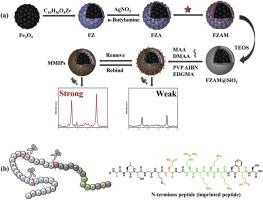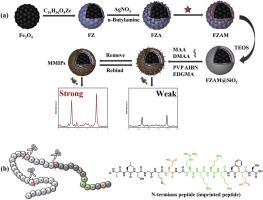基于蛋白水解肽技术的用于测定心肌肌钙蛋白 I 的磁性 SERS 压印传感器
IF 5.7
2区 化学
Q1 CHEMISTRY, ANALYTICAL
引用次数: 0
摘要
急性心肌梗死是一种突发性高死亡率疾病,可通过测量血液中的心肌肌钙蛋白 I 水平来准确诊断。目前,临床上常用的 cTnI 检测方法通常具有极高的灵敏度,适用于大规模样本检测分析。但这些方法大多需要经过固定、孵育、反应、分离等多个步骤,且大多需要专业人员操作复杂的仪器,大大限制了其在实时快速检测中的适用性。因此,一种对专业技能要求不高且能进行快速检测的方法就显得尤为必要。我们提出了一种结合使用 SERS 和磁性分子印迹聚合物(MMIP)来定量检测临床血清样本中 cTnI 的替代方法。MMIPs 以特征肽为模板,MAA 和 DMAm 为功能单体,在聚乙烯吡咯烷酮(PVP)条件下合成,无乙烯基修饰。在 MMIPs 中通过 Ag-SH 键连接了内部拉曼探针 4-MBA,从而解决了目标物没有拉曼特征峰的问题。具有高磁性和吸附性的 MMIPs 在特定捕获目标模板后,在拉曼位移 1582 cm-1 处显示出特征吸收峰。由于屏蔽效应,4-MBA 的拉曼信号减弱,该方法的检测范围为 0.001-100 ng-mL-1。加标实验的回收率和相对标准偏差(RSD)分别为 103.1%-106.3%和 3.54 %-7.38%。总之,该方法具有适当的灵敏度和特异性,ELISA 验证后的检测结果无明显差异。它为基于 SERS 技术检测 cTnI 提供了一种灵活实用的分析方法。此外,还可以通过改变模板分子制备其他疾病标志物的印迹材料,为其他生物标志物的检测提供了新思路。本文章由计算机程序翻译,如有差异,请以英文原文为准。


A magnetic SERS-imprinted sensor for the determination of cardiac troponin I based on proteolytic peptide technology
Acute myocardial infarction is a sudden and high-mortality disease that can be accurately diagnosed by measuring the level of cardiac troponin I in the blood. Currently, cTnI commonly used clinical detection methods usually have excellent sensitivity and are suitable for large-scale sample detection analysis. However, most of these methods are operated through multiple steps of fixation, incubation, reaction and separation, and most of them require professionals to operate complex instruments, which greatly limits their applicability in real-time rapid detection. Therefore, a method that requires low professional skills and can perform rapid detection is necessary. We presents an alternative strategy to quantify cTnI in clinical serum samples using a combination of SERS and magnetic molecularly imprinted polymers (MMIP). MMIPs was synthesized under Polyvinyl Pyrrolidone (PVP) conditions without vinyl modification using characteristic peptide as template, MAA and DMAm as functional monomers. The internal Raman probe 4-MBA was connected through Ag-SH bonds in MMIPs to solve the problem that the target object had no Raman characteristic peak. MMIPs with high magnetic and adsorptive properties showed characteristic absorption peaks at the Raman shift of 1582 cm−1 after specific capture of the target templates. The Raman signals of the 4-MBA were reduced due to shielding effects and the detection range of this method was 0.001–100 ng mL−1. The recoveries and relative standard deviations (RSDs) of the spiked experiments were 103.1%–106.3 % and 3.54 %–7.38 %, respectively. In summary, this work had appropriate sensitivity and specificity, and there was no significant difference in detection results after ELISA verification. It provided a flexible and practical analysis method for detecting cTnI based on SERS technology. In addition, the imprinting materials of other disease markers can be prepared by changing the template molecules, which provides a new idea for the detection of other biomarkers.
求助全文
通过发布文献求助,成功后即可免费获取论文全文。
去求助
来源期刊

Analytica Chimica Acta
化学-分析化学
CiteScore
10.40
自引率
6.50%
发文量
1081
审稿时长
38 days
期刊介绍:
Analytica Chimica Acta has an open access mirror journal Analytica Chimica Acta: X, sharing the same aims and scope, editorial team, submission system and rigorous peer review.
Analytica Chimica Acta provides a forum for the rapid publication of original research, and critical, comprehensive reviews dealing with all aspects of fundamental and applied modern analytical chemistry. The journal welcomes the submission of research papers which report studies concerning the development of new and significant analytical methodologies. In determining the suitability of submitted articles for publication, particular scrutiny will be placed on the degree of novelty and impact of the research and the extent to which it adds to the existing body of knowledge in analytical chemistry.
 求助内容:
求助内容: 应助结果提醒方式:
应助结果提醒方式:


